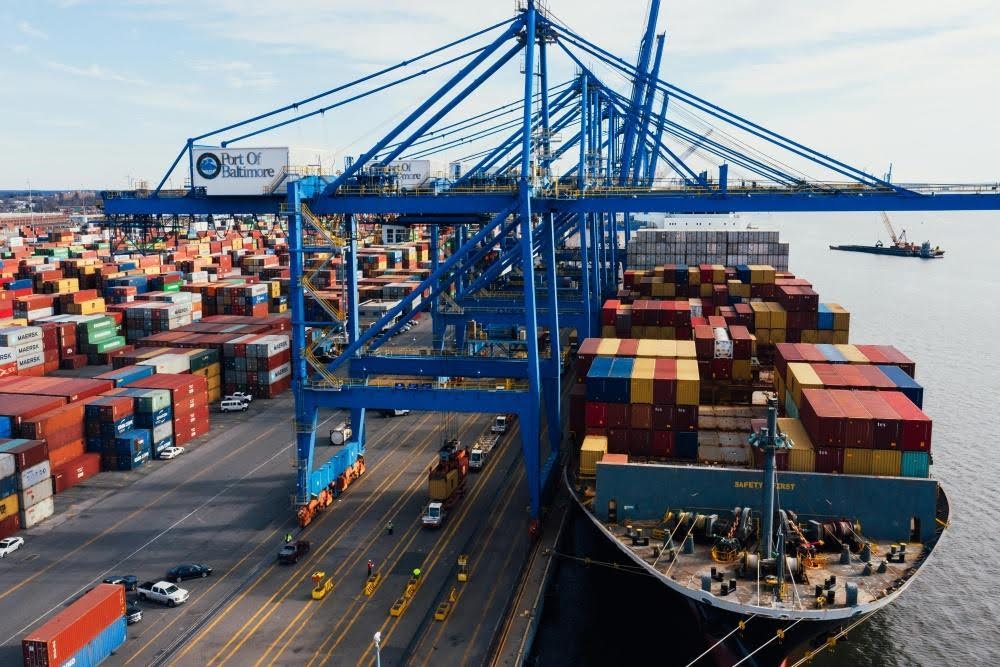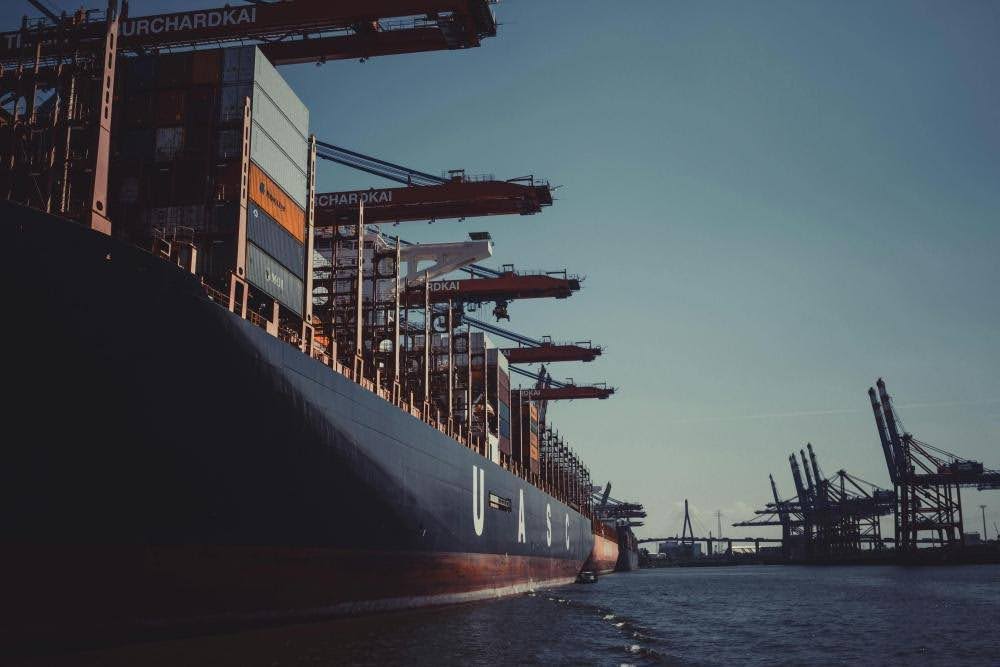We are witnessing an ever-increasing demand in global trade volumes driven by globalisation, economic growth in emerging markets, and the expanding reach of e-commerce. As trade volumes increase, implementing efficient transport solutions like sea freight becomes essential to sustain global commerce.
Since 1990, the volume of trade conducted via ocean freight has consistently increased, underscoring its importance in international trade dynamics. According to Statista, approximately 80% of goods today are transported by sea, highlighting the critical role and widespread reliance on sea freight as a fundamental pillar of global trade efficiency.
If you are a business looking to optimise your logistics, understanding the nuances of sea shipping is essential to determine if this mode of transport suits your needs. This article aims to break down the vital aspects of ocean freight, providing you with the insights needed to make informed decisions about your shipping strategy.
WHAT IS SEA FREIGHT?
Sea freight, also referred to as ocean freight, is the transport of goods by ship over the sea. It plays a crucial role in global logistics and international trade, offering a reliable and cost-effective method for moving large quantities of goods.
As a fundamental component of cross-border trade, sea freight enables economies to import and export goods on a scale that is not always feasible with other transportation modes like air or road.
HOW DOES SEA FREIGHT WORK?
The process of shipping goods by sea involves several key players:
- Shipping lines: Vessel operators that transport goods across the ocean, managing the schedules and network of maritime routes.
- Freight forwarders: Service providers that act as intermediaries, coordinating the logistics of moving goods from producers to market, including storage, handling, and shipping arrangements.
- Ports: The pivotal hubs where goods are loaded onto and unloaded from ships, managed by port authorities to facilitate international trade efficiently.
The journey of goods using ocean freight begins when exporters or manufacturers hand over their cargo to sea freight forwarders, who are responsible for ensuring the goods reach their shipping point. The freight forwarders then coordinate with shipping lines to book space on vessels and manage the preparation of shipping documents.
Once ready, the cargo is transported to ports, where it is loaded onto ships designated by the shipping lines. These ships navigate predefined maritime routes, crossing oceans to reach the designated destination ports.
Upon arrival, the goods are unloaded at the port, which acts as a crucial interchange for international trade. At this stage, cargo must undergo customs clearance, a critical process involving the assessment and verification of goods and documentation to ensure compliance with local laws and regulations. This step is vital for releasing goods into the domestic market or for re-export.
WHO USES SEA FREIGHT?
Sea freight can be utilised by a wide range of businesses and industries. However, it is particularly favoured by industries that need to transport large volumes of goods or bulky, heavy items that are not economically viable to send by air.
Industries such as mining, manufacturing, automotive, agriculture, and electronics regularly rely on sea freight for their logistic needs due to their capacity to handle large-scale shipments efficiently.
It’s important to note that there are special requirements for shipping hazardous, perishable, or sensitive goods, which necessitate the use of specially designed containers. This is why using an experienced sea freight forwarder like Halcon Primo Logistics is crucial, as they can provide expert advice and ensure compliance with all shipping regulations.

WHAT ARE THE DIFFERENT TYPES OF CARGO SHIPPED THROUGH THE SEA?
The versatility of sea freight allows for the transportation of diverse cargo types. This includes:
1. BULK CARGO
Bulk cargo consists of loose materials such as grains, coal, or minerals that are loaded directly into the ship’s hold without any specific packaging.
2. BREAK BULK
Break bulk cargo includes goods too large or heavy to be placed in standard shipping containers and must be handled individually. Items such as machinery, construction materials, and oversized equipment are common examples, requiring specialised loading and handling techniques.
3. CONTAINERISED CARGO
Containerised cargo involves goods securely packed into shipping containers, which is the most common method for transporting manufactured products.
Containers are used as they standardise dimensions and simplify the handling, loading, and unloading processes across global shipping facilities.
4. LIQUID CARGOES
Liquid cargoes, such as oils, chemicals, and certain gases, are transported in specially designed tankers that are equipped to handle the movement and storage of liquid substances. These tankers ensure the safe and efficient transportation of volatile and non-volatile liquids through the sea.
WHAT ARE LCL AND FCL IN SEA FREIGHT?
In sea freight, two common terms you’ll encounter are Less than Container Load (LCL) and Full Container Load (FCL). These terms are essential in determining how cargo is shipped based on the volume it occupies within a container. In sea freight, the volume of cargo a shipper has significantly influences whether they should opt for LCL or FCL.
LCL is chosen when the cargo doesn’t require the full space of a container. In this scenario, the shipper’s goods are consolidated with others’ shipments in a single container. This option is cost-effective for smaller shipments as it allows shippers to pay only for the space they use. However, it might involve longer transit times due to the additional handling required to consolidate and deconsolidate various shipments.
On the other hand, FCL is selected when a shipper has enough goods to fill an entire container on their own. This method gives the shipper greater control over the contents and the condition of the container throughout the journey. Since the container is exclusively used for one shipment, it typically moves directly from the seller to the buyer without being opened en route, which can lead to faster shipment times and reduce the risk of damages or losses during handling. FCL is often more cost-effective for larger volumes of goods and is preferable for delicate or high-value cargo that benefits from minimal handling.
WHAT ARE THE ADVANTAGES AND DISADVANTAGES OF SEA FREIGHT?
Deciding if ocean freight is the most suitable transportation option for your end-to-end logistics involves weighing a variety of factors. This method of shipping has several distinct advantages and disadvantages that can impact the efficiency and cost-effectiveness of global supply chains.
Below, we explore the key pros and cons of using sea freight to help businesses make informed decisions based on their specific shipping requirements, budget constraints, and timelines.
ADVANTAGES OF SEA FREIGHT
1. COST-EFFECTIVE
Sea freight is more economical for transporting large volumes due to lower fuel costs per tonne compared to air or road transport. Additionally, shipping by sea generally incurs lower duties, taxes, and VAT compared to air freight.
2. WELL-SUITED FOR HEAVY CARGO
Ocean freight is ideal for moving heavy and oversized loads such as vehicles, large machinery, industrial parts, and construction materials which cannot be loaded onto a place.
3. SAFE & LOW-RISK
Sea freight can safely transport hazardous materials. This is because the shipping crews are highly trained, containers are securely sealed, and regular inspections ensure the safety of the cargo and the environment during transit.
4. ENVIRONMENT FRIENDLY
According to the International Chamber of Shipping, shipping by sea is recognised as the most efficient form of commercial transport. This is because it produces the least CO2 emissions per tonne of cargo transported one mile compared to land and air freight.
DISADVANTAGES OF SEA FREIGHT
1. TIME-CONSUMING
Sea transit times are typically longer due to the inherently slower speeds of ships compared to aeroplanes. The vast distances covered by sea routes, coupled with factors like routing and port stops, contribute to extended delivery times.
2. INCREASED CHANCES OF DAMAGE
Cargo transported by sea may face increased risks of damage due to rough sea conditions and extensive handling during the loading and unloading processes. These elements can expose goods to potential harm, especially over long journeys.
3. WEAKER CONNECTIVITY
Some regions may lack the infrastructure to handle large container ships. This means that longer and less direct routes might have to be taken, increasing transit times and complicating the logistics of reaching remote destinations.
HOW LONG DOES SEA FREIGHT TAKE?
Transit times for sea freight can take anywhere from 1 to 8 weeks. However, this time varies widely depending on the route, weather conditions, and port efficiency. Furthermore, other factors such as the distance between ports, the speed of the vessel, and customs clearance times will also affect how long a sea shipment will take.
HOW MUCH DOES SEA FREIGHT COST?
Sea freight costs are composed of several components, including shipping fees, port charges, and various ancillary fees. These costs are subject to fluctuations influenced by factors such as fuel prices, chosen shipping routes, seasonal demands, and changes in international trade regulations.
Additionally, the costs can vary considerably when engaging a sea freight forwarder. Different freight forwarders have unique pricing structures and service fees based on their service levels, network capabilities, and contractual arrangements with carriers.
Therefore, it is crucial for shippers to consider these variables when evaluating the total cost of sea freight to ensure the most cost-effective and efficient shipping solution.
IS IT BETTER TO SHIP BY SEA OR AIR?
The decision to choose between sea and air freight hinges on multiple factors such as cost, speed, and the specific nature of the goods being transported. Air freight offers the advantage of speed, making it ideal for time-sensitive shipments, but it comes at a higher cost and has limitations regarding the volume and weight of cargo it can handle.
In contrast, sea freight is more cost-effective for shipping large volumes or heavy cargo. It provides a more economical solution for non-urgent deliveries, accommodating larger and heavier shipments that would be impractical or too expensive to send by air.
Ultimately, the choice between sea and air freight depends on your specific needs. For example, a business shipping bulk construction materials that are not time-sensitive would likely opt for sea freight due to its cost-effectiveness and ability to handle heavy loads, making it a more practical and economical choice compared to air freight.
SEA FREIGHT CHARGES FROM HALCON PRIMO LOGISTICS
With an extensive range of sea freight forwarding services, Halcon Primo Logistics ensures timely, cost-efficient, and secure delivery of your cargo.
Leveraging over 18 years of industry experience and a vast network of global partners, we are a top choice for Non-Vessel Operating Common Carrier (NVOCC) services in Singapore. We offer both Less than Container Load (LCL) shipments and Full Container Load (FCL) shipments to meet the varying demands of various industries, including FMCG, Tech, Automotive, and more, with minimised risks and costs.
Additionally, unlike other freight forwarding services in Singapore, we provide a comprehensive suite of supply chain management solutions. By collaborating with our trusted partners at every port, we deliver a seamless one-stop solution for all your import clearance needs.
For expert sea freight forwarding and end-to-end logistic services that you can rely on, choose Halcon Primo Logistics. Reach out to our team today to learn more about our sea freight forwarding charges and services!


